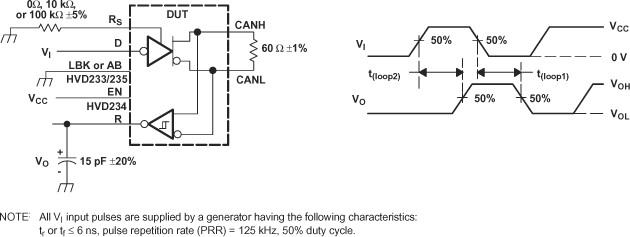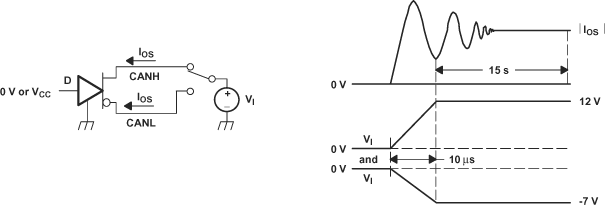SLLS557H November 2002 – November 2018 SN65HVD233 , SN65HVD234 , SN65HVD235
PRODUCTION DATA.
- 1 Features
- 2 Applications
- 3 Description
- 4 Revision History
- 5 Description (continued)
- 6 Device Comparison Table
- 7 Pin Configuration and Functions
-
8 Specifications
- 8.1 Absolute Maximum Ratings
- 8.2 ESD Ratings
- 8.3 Recommended Operating Conditions
- 8.4 Thermal Information
- 8.5 Power Dissipation Ratings
- 8.6 Electrical Characteristics: Driver
- 8.7 Electrical Characteristics: Receiver
- 8.8 Switching Characteristics: Driver
- 8.9 Switching Characteristics: Receiver
- 8.10 Switching Characteristics: Device
- 8.11 Typical Characteristics
- 9 Parameter Measurement Information
- 10Detailed Description
- 11Application and Implementation
- 12Power Supply Recommendations
- 13Layout
- 14Device and Documentation Support
- 15Mechanical, Packaging, and Orderable Information
Package Options
Refer to the PDF data sheet for device specific package drawings
Mechanical Data (Package|Pins)
- D|8
Thermal pad, mechanical data (Package|Pins)
Orderable Information
9 Parameter Measurement Information
 Figure 12. Driver Voltage, Current, and Test Definition
Figure 12. Driver Voltage, Current, and Test Definition  Figure 13. Bus Logic State Voltage Definitions
Figure 13. Bus Logic State Voltage Definitions  Figure 14. Driver VOD
Figure 14. Driver VOD 
A. The input pulse is supplied by a generator having the following characteristics: Pulse repetition rate (PRR) ≤ 125 kHz, 50% duty cycle, tr ≤ 6 ns, tf ≤ 6 ns, ZO = 50 Ω.
B. CL includes fixture and instrumentation capacitance.
Figure 15. Driver Test Circuit and Voltage Waveforms  Figure 16. Receiver Voltage and Current Definitions
Figure 16. Receiver Voltage and Current Definitions 
A. The input pulse is supplied by a generator having the following characteristics: Pulse repetition rate (PRR) ≤ 125 kHz, 50% duty cycle, tr ≤ 6 ns, tf ≤ 6 ns, ZO = 50 Ω.
B. CL includes fixture and instrumentation capacitance.
Figure 17. Receiver Test Circuit and Voltage Waveforms Table 1. Differential Input Voltage Threshold Test
| INPUT | OUTPUT | MEASURED | ||
|---|---|---|---|---|
| VCANH | VCANL | R | |VID| | |
| –6.1 V | –7 V | L | VOL | 900 mV |
| 12 V | 11.1 V | L | 900 mV | |
| –1 V | –7 V | L | 6 V | |
| 12 V | 6 V | L | 6 V | |
| –6.5 V | –7 V | H | VOH | 500 mV |
| 12 V | 11.5 V | H | 500 mV | |
| –7 V | –1 V | H | 6 V | |
| 6 V | 12 V | H | 6 V | |
| Open | Open | H | X | |

NOTE:
This test is conducted to test survivability only. Data stability at the R output is not specified.
NOTE:
All VI input pulses are supplied by a generator having the following characteristics: tr or tf ≤ 6 ns, pulse repetition rate (PRR) = 125 kHz, 50% duty cycle. Figure 20. Ten(z) Test Circuit and Voltage Waveforms
Figure 20. Ten(z) Test Circuit and Voltage Waveforms  Figure 21. VOC(pp) Test Circuit and Voltage Waveforms
Figure 21. VOC(pp) Test Circuit and Voltage Waveforms  Figure 22. T(loop) Test Circuit and Voltage Waveforms
Figure 22. T(loop) Test Circuit and Voltage Waveforms  Figure 23. T(LBK) Test Circuit and Voltage Waveforms
Figure 23. T(LBK) Test Circuit and Voltage Waveforms  Figure 24. T(AB1) Test Circuit and Voltage Waveforms
Figure 24. T(AB1) Test Circuit and Voltage Waveforms  Figure 25. T(AB2) Test Circuit and Voltage Waveforms
Figure 25. T(AB2) Test Circuit and Voltage Waveforms  Figure 26. IOS Test Circuit and Waveforms
Figure 26. IOS Test Circuit and Waveforms 
NOTE:
All input pulses are supplied by a generator with f ≤ 1.5 MHz. Figure 28. Equivalent Input and Output Schematic Diagrams
Figure 28. Equivalent Input and Output Schematic Diagrams